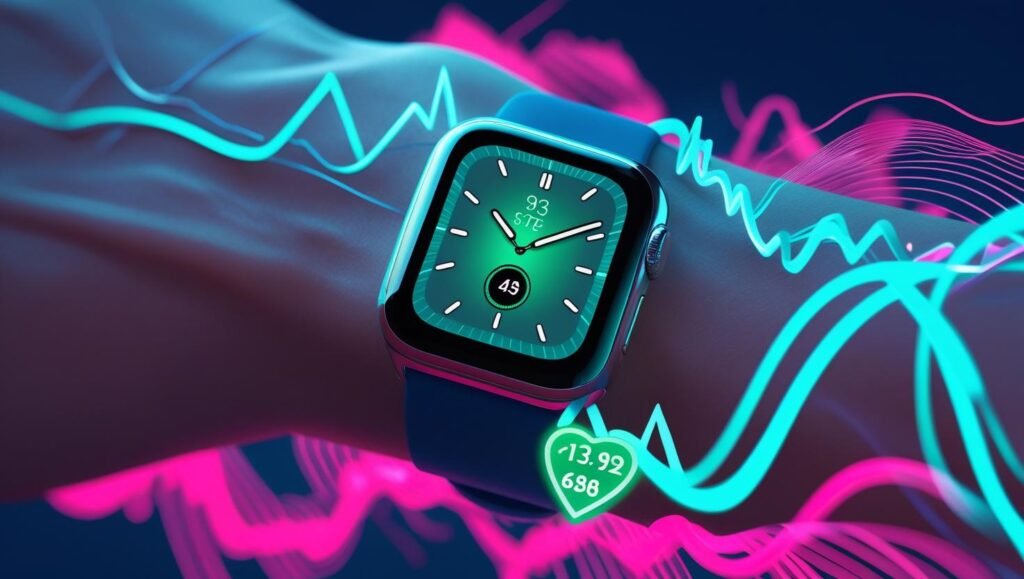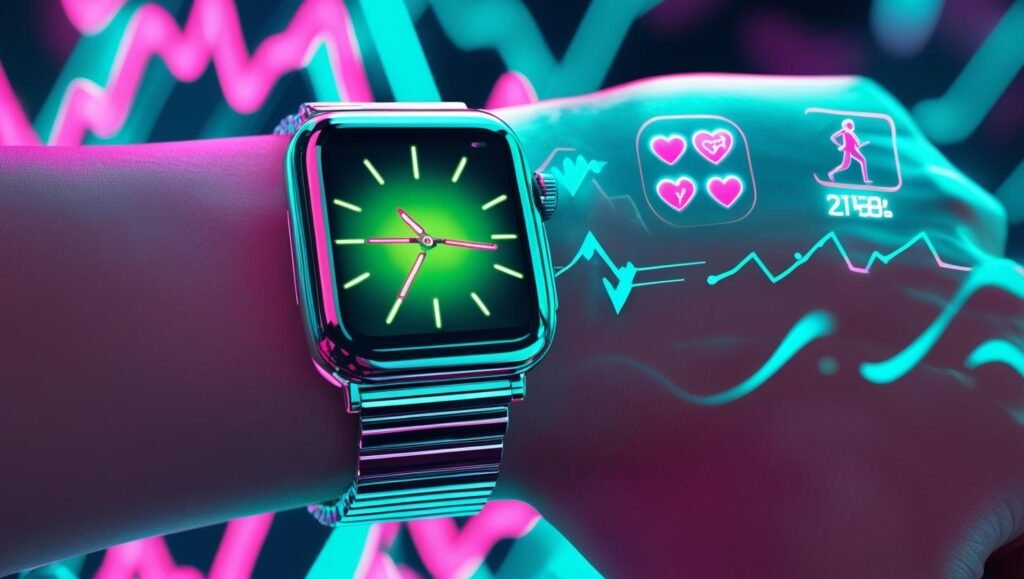IoT in Wearable Tech Monitors You in Real Time

Imagine a tiny device on your wrist that tracks your heart rate, sleep, and even stress levels, all while sending that info to your phone in real time. That’s the magic of IoT in wearable tech! The Internet of Things (IoT) connects devices to the internet, letting them share data instantly. In wearable tech, like smartwatches and fitness bands, IoT helps you stay on top of your health and fitness goals. This blog post will explain how IoT in wearable tech works, its benefits, and why it’s changing how we care for ourselves.
What Is IoT in Wearable Tech?
IoT in wearable tech refers to devices like smartwatches, fitness trackers, or even smart clothing that connect to the internet. These gadgets collect data about your body—like steps taken, calories burned, or heart rate—and send it to apps or cloud systems for analysis. The “Internet of Things” part means these devices talk to each other, your phone, or even your doctor’s system, all in real time.
Wearables use sensors to gather data. For example, a smartwatch might have a heart rate sensor or a motion detector. IoT makes sure this data is shared instantly, so you can act on it right away, like adjusting your workout or checking in with a doctor.
Why Is IoT Important in Wearables?
IoT makes wearable tech smarter and more helpful. Without it, your fitness tracker would just be a fancy pedometer. With IoT, it becomes a powerful tool that gives you real-time insights. Here are some reasons why IoT in wearable tech matters:
- Real-Time Updates: You get instant feedback, like knowing your heart rate during a run.
- Personalized Insights: IoT analyzes your data to suggest better habits, like drinking more water.
- Remote Monitoring: Doctors can check your health without an office visit.
- Seamless Connection: Your wearable syncs with your phone or other devices effortlessly.
How Does IoT in Wearable Tech Work?
IoT in wearable tech sounds high-tech, but it’s pretty simple when you break it down. These devices use a few key parts to monitor you in real time. Let’s look at how it all comes together.
Sensors: The Heart of Wearables
Every wearable has tiny sensors that measure things like your heart rate, steps, or even blood oxygen levels. For example, a fitness band might use an optical sensor to check your pulse by shining light on your skin. These sensors collect data constantly while you wear the device.
Connectivity: Sending Data Instantly
IoT in wearable tech relies on connectivity, like Bluetooth, Wi-Fi, or cellular networks. Once the sensors collect data, the device sends it to your phone or a cloud server. This happens in real time, so you can open an app and see your stats instantly. Some devices even connect directly to your doctor’s system for remote health checks.
Data Analysis: Turning Numbers into Insights
The real power of IoT in wearable tech comes from analyzing the data. Apps or cloud systems process the information from your wearable to give you useful insights. For example, if your heart rate spikes during a workout, the app might suggest slowing down. Over time, it can spot patterns, like if you’re not sleeping well.
Example of IoT in Action
Here’s a quick example of how IoT in wearable tech works:
- You wear a smartwatch while jogging.
- The watch’s sensors track your heart rate and distance.
- The data is sent via Bluetooth to your phone.
- The app analyzes it and tells you if you’re pushing too hard.
- If needed, it alerts your doctor about unusual heart activity.
This whole process happens in seconds, keeping you informed and safe.
Benefits of IoT in Wearable Tech
IoT in wearable tech isn’t just cool—it’s life-changing. It helps you take control of your health, stay motivated, and even catch problems early. Let’s explore some key benefits.
Stay on Top of Your Health
Wearables with IoT let you monitor your health 24/7. You can track your heart rate, sleep quality, or stress levels without guessing. For example, if your smartwatch notices an irregular heartbeat, it can warn you to see a doctor. This real-time monitoring helps you catch issues before they become serious.
Reach Fitness Goals Faster
If you’re trying to get fit, IoT in wearable tech is like having a personal coach. It tracks your steps, calories, and workouts, giving you real-time feedback. For instance, a fitness tracker might buzz to remind you to move if you’ve been sitting too long. It can also suggest workouts based on your progress.
Connect with Healthcare Providers
IoT in wearable tech makes it easy to share data with doctors. Some wearables send your health stats directly to your doctor’s system. This is super helpful for people with chronic conditions like diabetes or heart disease. Your doctor can check your data remotely and adjust your treatment if needed.
Save Time and Stay Motivated
With IoT, your wearable does the hard work of tracking and analyzing data. You don’t need to write down your workouts or guess how many calories you burned. Plus, many apps use IoT data to send you motivational messages or rewards, keeping you excited about your goals.

Challenges of IoT in Wearable Tech
While IoT in wearable tech is amazing, it’s not perfect. There are some challenges to keep in mind. Knowing these can help you use wearables more effectively.
Privacy and Security Concerns
Since IoT in wearable tech collects personal data, like your heart rate or location, privacy is a big deal. If the data isn’t protected, hackers could access it. To stay safe, choose trusted brands and keep your device’s software updated.
Battery Life Limitations
Wearables need power to run sensors and stay connected. Some devices drain their battery quickly, especially with constant IoT use. Newer models are improving, but you might need to charge daily.
Data Overload
With so much data from IoT in wearable tech, it’s easy to feel overwhelmed. Not everyone knows how to interpret heart rate graphs or sleep scores. Look for devices with simple apps that explain your data clearly.
Who Can Benefit from IoT in Wearable Tech?
IoT in wearable tech is for everyone, not just fitness buffs. Here’s how different people can use it:
| Who | How They Benefit |
|---|---|
| Fitness Lovers | Track workouts, set goals, and improve performance. |
| Seniors | Monitor heart rate or detect falls for safety. |
| People with Chronic Conditions | Share real-time data with doctors for better care. |
| Busy Professionals | Get reminders to move or manage stress levels. |
No matter your age or lifestyle, IoT in wearable tech can help you live healthier.
The Future of IoT in Wearable Tech
The future of IoT in wearable tech is exciting! New devices are getting smarter and smaller. Soon, we might see wearables like smart contact lenses that track blood sugar or clothing that monitors posture. IoT will keep making these devices more connected, giving us even better insights into our health.
Companies are also working on fixing challenges like battery life and privacy. For example, some wearables now use AI to analyze data right on the device, reducing the need to send sensitive info to the cloud. As IoT in wearable tech grows, it’ll become an even bigger part of our daily lives.
Conclusion
IoT in wearable tech is transforming how we monitor our health and fitness. From tracking your steps to alerting your doctor about a heart issue, these devices make staying healthy easier and more connected. While there are challenges like privacy or battery life, the benefits outweigh the drawbacks for most people. Whether you’re a fitness newbie or managing a health condition, IoT in wearable tech can help you live better. So, why not try a wearable and see how it can work for you?
FAQs
What is IoT in wearable tech?
It’s when wearable devices, like smartwatches, use the Internet of Things to collect and share data about your health or fitness in real time.
Is my data safe with IoT wearables?
Most trusted brands use strong security, but you should keep your device updated and avoid sharing sensitive data on unsecured networks.
Can IoT wearables help with medical conditions?
Yes! They can track things like heart rate or blood sugar and share that info with your doctor for better care.
Read more: IoT Security Risks You Must Fix Right Now




